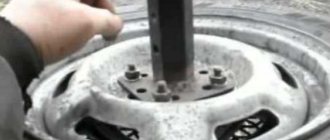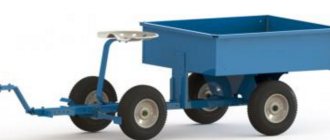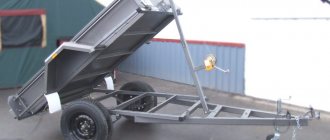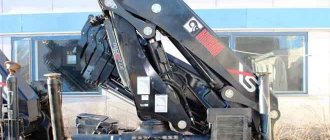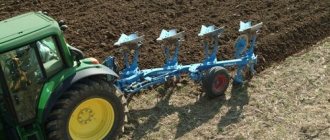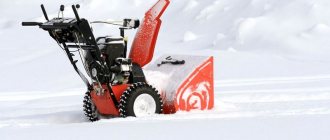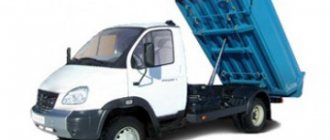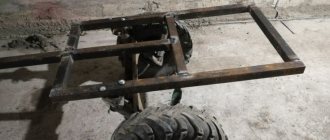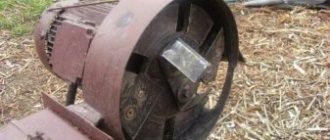The cart frame is best made from 50x25x4 mm pipes, which will include a direct welded riser, front and rear side members. A 40x40x4 mm corner can act as a reinforcing cross member, and a 58x4 mm pipe can act as a longitudinal hinge. It is best to do everything by welding, as this will ensure the strength and integrity of the structure, eliminating the possibility of elements loosening (when using bolted fastening). Next, you should weld the seat posts from 40x40x4 mm corners, to which the wooden frame of the immediate body will be attached.
Selecting suitable wheels and mounting them
– step-by-step assembly
In order for the dump cart to be balanced and strong enough, during its manufacture you need to follow the correct procedure.
The assembly algorithm should look like this:
- First of all, the manufacturer must make a reliable supporting frame. Its design should include a front traverse, a stable central axis with reinforcement in the form of a plate blade, as well as a powerful rear beam. For the manufacture of each of the frame elements, thick pipes are suitable, the cross-section of which must be at least 25 cm. Welding is used to fasten the pipes. To prevent the structure from swaying during movement in the future, it needs to be strengthened with spars made from channel bars and installed on the sides. You will need to install gussets where the side members and rear beam are attached - they will make the tractor trailer more resistant to vibration when driving off-road;
- Then you need to start assembling the wheelbase. Its standard axle is best made in the form of a metal rod with a diameter of approximately 30–35 cm. After this, the axle will need to be attached to the supporting frame using longitudinal hinges, side metal spars or supports made from angle steel. A homemade cart made in this way will be able to successfully transport not only crops, but also various building materials;
- Next you need to move on to assembling the body. It can be made from thick boards or sheet steel. The second option will allow you to transport heavier loads. You need to attach the metal to an ordinary corner, which plays the role of a base. You will need to attach the sides of the cart using the same method. Thanks to this, the homemade structure will not warp during sharp turns;
- At the next stage, you need to move on to the manufacture of the trailing mechanism. It is best to assemble a drawbar, which will fit into a special canvas during operation of the trailer. It is important that the supporting frame of the cart is in an ideal horizontal position. If it is broken, then the tractor cart mount will need to be adjusted. Otherwise, the structure will not be able to withstand the friction and intense vibration that the agricultural machine creates during movement;
- Then you need to assemble the trailer lifting mechanism. It must be based on a hydraulic cylinder capable of tilting the cart by 50⁰. To connect the lift to the frame, the manufacturer will need to assemble a strut that follows the shape of a truncated triangle. To make it, a channel is suitable, on top of which a stop should be attached - it can be made from a cut metal sheet. To operate the lifting mechanism, you will need to connect pipes to the hydraulic drive of the tractor. The video will tell you more about making a homemade trailer.
The finished tractor cart will need to be coated with a layer of primer and several layers of paint applied. This will protect the metal parts of the structure from the formation of rust and rot.
In order for the cart to withstand intensive use and serve its owner for as long as possible, you must follow the rules for its use.
To do this, the user needs:
- Try to avoid overloading the tractor trailer. If you carry more weight on a cart than it can support, then this threatens to upset the balance and loss of structural rigidity. Over time, the trailer will skew to one side and it will be impossible to transport cargo on it, especially bulk cargo;
- control the pressure in the hydraulic pipes - a sharp drop or surge in pressure in the system will lead to the inability of the trailer to rise for unloading. This can happen at any inopportune moment, so the user should check the air pressure in the tubes and their integrity before each time they leave the house.
To avoid most of these problems, you should try not to use a tractor trailer to transport large luggage over severe off-road conditions. This will reduce the risk of increased load on the supporting frame of the cart and prevent it from tilting away from the central axis.
Total mechanization, which has unfolded since the second half of the last century, has led to the fact that today almost every sector of the national economy has at its disposal all the necessary equipment that makes it possible to completely shift the sometimes unbearable physical burden onto the shoulders of smart and automated technology.
Agriculture is far from an exception in this case, since it is the most labor-intensive and at the same time responsible production sector that is considered the leader in the number of rational inventions that have made our lives easier and more comfortable.
One of these units is a tractor, which can be aggregated not only with all kinds of attachments and plows for tillage purposes, but also with other trailed devices, such as a bucket or, most often, a trailer. Although a tractor trailer does not eliminate the physical work of laying cargo, it helps in another way – in transporting it over long distances. And if we add to this the possibilities for automated shipment provided by the design, the farmer’s task is simplified several times.
Such a unit is a rather expensive purchase, which is beyond the capabilities of every farmer. But there is always the opportunity to do it yourself. What types of trailers there are, how they are designed and what is required to make them will be discussed in our article.
This category of agricultural machinery belongs to the category of special-purpose mechanical elements, which, with their design, size, weight and functionality, must fully comply with the specific agricultural purposes and technical features of the original tractor machine to which they plan to attach it.
Their device is extremely simple:
- chassis and wheelbase;
- frame base element;
- the body itself;
- lifting mechanism;
- drawbar (attachment to the tractor itself).
In accordance with their functionality, the following types of towed devices are distinguished:
- single-axle - a universal option that can be adapted for all categories of cargo transportation, not only bulk, but also in a liquid or semi-liquid state. They are most often found in the agricultural sector, as well as in construction work;
- biaxial - they cope well with transporting heavy loads of any volume and quantity, even if they are small agricultural units.
Another important point is how the trailer will be freed from loaded material. In this regard, trailed equipment is:
- self-tipping - its design is based on the principle of a conventional dump truck, reminiscent of a mechanical lever;
- forced lifting – in which the use of external mechanical means is necessary to lift the body part. This could be a high-power motor, an oil pump, or car lifts that are mounted directly under the body.
The first option is undoubtedly more convenient. It implies the presence of a central axis under the body structure, which is supported on it using hinge elements or simply bearings. The body is lifted by a lever mechanism, which must be locked to prevent spontaneous overturning.
Safety precautions
Regardless of the design features, a mini-tractor trailer requires careful handling. First of all, you must not use the trolley with an overload, or carry easily shifting loads on it in an unsecured position. Before each trip and upon return, you need to check the serviceability of the trailer itself and its hitch. If you discover a malfunction, you should fix it immediately, and only then use the trailed cart again. Be sure to remove all roughness and metal burrs.
It is strictly forbidden to ride in a trailer and carry pets in it.
When stopping the vehicle, even for the shortest time, you should put the handbrake on. Limits on the steepness of the climb must be strictly observed. When working on a slope, drive at a minimum speed.
Many owners of large fields and gardens buy tractors not only for cultivating the soil, but also for the ability to transport crops and equipment. For this purpose, a trailer is installed on the agricultural machine. One of the main advantages of this design is that you can assemble it yourself. Given the correct procedure, the manufacturer can obtain a reliable and durable cart of almost any shape and size.
First of all, before directly assembling the tractor trailer, the manufacturer will need to study detailed diagrams, which should indicate the dimensions of the parts used, as well as the order and method of their installation in the overall structure.
The drawings indicate that the tractor cart should consist of several parts.
Their list includes:
- frame – the main strength element;
- chassis, including wheelbase;
- body;
- lifting part;
- a drawbar with which the trailer will be attached to a utility tractor.
To assemble each of these elements, the manufacturer will need:
- a pair of sheets of steel;
- steel or metal channel;
- blanks made of thick plywood;
- metal pipes;
- chassis block;
- 1–2 pairs of identical wheels;
- electrical connection equipment;
- Bulgarian;
- fasteners.
If you have all the materials and equipment, you can assemble the following types of carts:
- single-axis - the simplest and most popular option. A single-axle tractor trailer can be used to work with any type of agricultural machinery. It can be used to successfully transport bulk, liquid or semi-liquid materials;
- biaxial - they are distinguished by their high resistance to particularly large and heavy luggage.
For unloading, the tractor cart must be equipped with a separate mechanism.
Depending on the principle of operation, carts are divided into the following types:
- tipping randomly - they work on the principle of an ordinary dump truck, which is driven by a mechanical lever;
- forced lifting - in these structures, lifting the body requires the use of technically complex foreign components. Most often, for this purpose, the tractor cart is equipped with an oil pump, engine or car lift.
The most convenient is considered to be a single-axle tractor cart, in which the components of the body are held on the central axis by means of hinges. To make unloading possible, the easiest way is to make a randomly tipping trailer. It will be activated by a lever, which must be equipped with a stopper to reduce the risk of the structure overturning.
Tipper single-axle trailer for tractor: 7-step instructions
For the description, we chose this particular design option, since it is the most convenient and most often used for agricultural work. It is advisable to present the entire cycle of its independent production in the form of 7 interconnected processes:
Step 1 - Organizational planning
During which a drawing is developed, the technical foundations for the future design are laid. The photo below shows a ready-made drawing of such an agricultural mechanism, but with a wooden body, which, if desired, can also be made in steel or metal form.
By following the established dimensional characteristics, you can get a fairly roomy and reliable cart with a stable wheel configuration and a powerful frame that will move even on the most difficult field roads without any problems. In addition, at this same stage it is necessary to prepare all the necessary initial parts and materials, namely:
- sheet steel;
- channel, preferably also made of steel or durable metal;
- plywood blanks;
- metal pipes, you can use the aluminum version;
- running block;
- wheels of the same diameter;
- electrical equipment;
- grinder or metal saw for trimming;
- elements for securing the structure.
It is very important to have electric welding on hand, which will not only simplify the process, but will also allow you to make a real monolithic mechanism, no worse than the factory one.
Step 2 - Making the supporting frame
Its design must necessarily have a front traverse, a powerful rear beam, and a main central axis reinforced with a plate cloth. It is better to make these components from pipes with a cross-sectional diameter of at least 0.4 m, which are connected to each other by welding. In order for the entire welded block to be static and not “walk” while driving, do not forget about the side spars made of channel bars. In addition, experienced craftsmen advise strengthening all connections of the side members and rear beam with gussets, which will give the structure an even more durable appearance;
Step 3 - Moving on to constructing the wheel base
Its axis can be represented in the form of a steel rod, the diameter of which is best taken 0.35 m. The wheel axle is attached to the frame itself, which is already welded, using longitudinal type hinges, supports from the corner or side spars. With this approach to compiling a body composition, we will get an excellent result, allowing us to significantly expand the field of activity of such equipment, which can handle not only cabbage or organic fertilizers, but also, for example, a cinder block for the construction of utility rooms (photo 8).
Step 4 - We begin the process of producing a homemade body
If you have suitable timber, you can make it wooden. If funds allow and you need a more reliable option for storing future heavy loads, it is better to pay attention to metal or sheet steel. Their overall configuration should be selected individually depending on the volume of work and the size of the transported mass (photo 9).
If this is a wooden product, you need to select boards of exceptional quality, which should not be raw and preferably solid, not from separate bars. They must be attached to a metal base - an ordinary corner. It is also worth securing the side positions of the trailer so that when the center of gravity shifts, the balance is not disrupted. There is another option for the frame - take a ready-made one, if of course you have one.
Step 5 - Having made the key elements for the hitch
It's time to start making the connecting structure of the frame itself with the body and wheels of the tractor. This may be a drawbar that goes into a special tubular sheet. In this case, you should ensure that the frame is in the correct horizontal position. otherwise, the mount will need to be balanced so that it can withstand the high friction and vibration generated by the tractor itself.
Step 6 - Lifting Component
For a hydraulic cylinder, you can take a ready-made lift that can tilt the body up to 50 0 and even more. In order for it to become part of the frame block, a special structure is made - a strut, shaped like a truncated triangle. It can be made from channel wood. The upper stop can be an ordinary circle, which can be cut from a metal sheet and then welded to the body frame. The hose from it can be connected to the hydraulic drive of the tractor itself.
Step 7 - Break-in
That very moment of assembly, which it is advisable to do not alone, but with assistants, so that the assembly is neat and of high quality, and all fastenings of hinges, bolts and other things are reliable and guarantee not only functionality, but also safety during field work. Like any other mechanism, a newly manufactured tractor cart must go through a running-in process, for which it is initially used without loads. Only after making sure that everything is in good order and ready for full operation can you begin introducing this home-made model into production.
In conclusion, it is worth noting that a tractor with a trailer is a more functional thing than without it. And the fact that there are no available funds to purchase a capital production modification of the cart can be easily eliminated by making it yourself from the available means at hand in almost every household.
Independent production of tractor trailers type 2 PTS-4 will not only allow you to save on the purchase of an expensive new unit, but will also give the start to a unique and profitable business!
It is impossible to imagine difficult agricultural everyday life without the use of dump trailers. You cannot do without them both during sowing and harvesting. But what if the prices for new trailers are quite high? The solution is simple - you need to build the trailer yourself!
Today we will look at all the nuances of manufacturing a tipper trailer type 2 PTS-4. After spending just a couple of days, you will become the owner of a high-quality multifunctional unit that will significantly simplify field and garden work. We will also analyze how profitable the production of tractor trailers is as a business.
Differences
The classification of this technology has its own characteristics, the main one of which is the number of axes. Trailers and carts for mini tractors can be 1-3 axle. Each axle is a pair of wheels. Accordingly, the more weight you need to transport, the more of them you need.
Dump trailers are used to transport bulk cargo. Externally, they are no different from the others, and can be either single-axis or biaxial, but they have an automatic unloading function. This type is designed for transporting building materials such as sand and crushed stone. But such a device will do an excellent job of transporting other solid loads. They can easily unload without any auxiliary equipment. The biggest advantage of this option is the saving of time and effort that would normally be spent on the unloading process.
On-board models mainly transport packaged cargo. It can be:
- boxes and containers with harvest;
- building materials;
- bales with straw.
This trailer is also suitable for transporting a mini tractor. In this case, the side is tilted, which helps to quickly load and unload.
Types of models
In terms of the number of axles, single-axle models and a compact two-axle dump truck version are suitable for a mini tractor. Two-wheeled units are suitable for quickly transporting small loads up to 200 kg. Most often, such models are similar to wheelbarrows for transporting construction materials, only instead of handles there is a special device for attaching an earring to a tractor. The photo shows single-axle trailers for mini tractors.
For transportation of medium-weight or large-volume loads, a two-axle tipper version of the trolley is better suited. This model is characterized by increased stability and can withstand weight up to 2 tons, although in practice no one overloads it over 1.2 tons. A two-axle trailer for a mini tractor may not have an unloading function, which is not a problem if you need to transport fruits, vegetables and other products that are best not dumped on the floor.
If you purchase a tipper trailer for a mini tractor, then it is better to use it for transporting bulk construction materials: crushed stone, sand, clay. This model is also useful when transporting grains. Thanks to the unloading function, the unit easily gets rid of the load. In some cases, this model is used for garbage removal, since it subsequently does not have to be unloaded manually.
DIY tractor trailer
To make a tractor trailer with your own hands, we offer you to download a free assembly in a 3D model with all the details of all components and dimensions. Using a 3D model, you can quickly and easily assemble a complete structure using a sample. This 3D model can be disassembled down to the bolt.
- Drawbar.
- Trolley frame.
- Spring suspension.
- Axle with wheels and brakes.
- Turning circle.
- Body frame.
- Rear beam.
- Hydraulic cylinder.
- Flatbed body.
- Body platform.
The preliminary drawing shows only the main components, which can be disassembled into the smallest details in the SolidWorks program. Using this 3D model you don't need drawings. Everything is visible at a glance, and the dimensions are displayed in the properties of the parts.
Chassis
First let's look at the wheel system. The chassis must be reliable and strong so that the platform installed on top can easily withstand any loads when transporting goods and unloading them.
Which tires should you choose? Experts advise taking a 9.0-16.0 model Ya-324A or NkF-8. We install disc wheels (brand 152F-406). Take care of a high-quality and reliable brake system, because often pneumatic single-line shoe brakes are installed on the front axle of tractor trailers 2 PTS-4. You can purchase all the necessary components at any local car market, as well as on various specialized Internet sites. When selecting, you can pay attention to used parts. This will significantly reduce your spending budget. The main thing is that they are fully operational and functional.
The chassis frame is welded from strong metal profiles.
The platform is lifted using a telescopic hydraulic cylinder attached to the middle of the frame. The rear suspension, mounted on semi-elliptic leaf springs, has an axle with wheels, as well as a special bracket for pulling out the trailer in an emergency and protective mud flaps.
The front suspension includes both a wheel axle and a swing bogie (see picture) to give your trailer maneuverability. The electrical and parking systems, as well as pneumatic and hydraulic systems, are mounted at the front. A fuse rack must be placed on the left side.
Platform and extensions
What does the body (platform) of trailer 2 PTS-4 consist of? If schematically, then from a rectangular base, sides, racks and special locks. At the bottom of the platform there are four support brackets, thanks to which it can be clearly secured to the towed frame. The front, rear and side parts of the platform are made of reliable profiled metal.
The design of the platform provides for the possibility of hinged fastening of extension sides, which allows increasing the volume of transported cargo to almost 12 cubic meters. Thanks to this, the process of transporting the harvested crop can be accelerated almost twice!
Modern carts - areas of use
In the modern world, three types of carts are used. The first type is a passenger cart. It is often used by both ordinary rural residents and city dwellers. In some areas, carts are the main method of transportation.
The second type of cart is a cargo cart. Thanks to its strong composition, it can transport various heavy loads. If a person has a horse, then he does not need to hire a car to transport things or hay.
The third type of cart is axleless, that is, wheelless sleigh. This type of cart is good to use in winter when there is loose snow.
It is important to note that the speed of a horse and cart reaches 6 km per hour
Tractor trailer 2 pts 4
The carrying capacity of the self-produced trailer 2 PTS-4 is 4 tons. The platform design of tractor trailers of this type is designed taking into account the transportation and unloading of bulk cargo. At the same time, it is permissible to load other types of cargo, which primarily include piece goods. The main thing is to ensure that the transported units are securely secured so that during transportation they do not fall out or overturn the trailer.
During manufacturing, you must adhere to the factory overall dimensions of the trailer. They look like this:
- Length – 5 m 83 cm.
- Width – 2 m 39 cm.
- Height – 1 m 94 cm.
- Height including two-tier sides – 2 m 47 cm.
For ease of operation, a trailer should be made with the ability to attach two-tier sides. This will cost several thousand rubles more, but at the same time you will be able to transport a much larger volume of agricultural cargo at a time.
To summarize, we note that the standard tractor dump trailer type 2 PTS-4 has three components:
- Chassis.
- Platform.
- Extension sides.
You already know what their installation diagrams look like and what spare parts you should purchase.
Features and Benefits
When transporting bulk cargo on a trailer, there are no special problems with loading them. But unloading is accompanied by the need to climb into the body and start scooping everything out manually, with shovels or other devices.
In such situations, the tipping mechanism becomes a real salvation. With its help, unloading is much easier and faster.
The following advantages of such systems can be cited:
- simplify the loading and unloading process;
- minimize human physical effort;
- the speed of unloading bulk cargo can be controlled;
- suitable for working with all kinds of loads;
- an indispensable device in agriculture and in the country;
- the mechanism can be installed with your own hands;
- does not interfere with the design of the trailer.
The essence of such a trailer is that its body has a movable connection to the frame. In conventional trailers, they are solid, which is why you can at most tip the entire trailer, including the tongue and wheels, backwards. This is inconvenient and potentially dangerous. Therefore, it is strongly not recommended to unload bulk cargo from ordinary flatbed trailers using this method.
Cost-effective production of trailers 2 PTS-4 with your own hands
Having carefully assembled all the parts, you will receive a functional trailer for your own use, which will cost almost two or even three times less than its factory counterpart. Having initially given preference to domestic components, you can easily carry out routine maintenance and replacement of parts in the future without significant costs.
Having perfectly mastered the production of tractor dump trailers type 2 PTS-4, you will be able to organize your own business in the production and sale of these irreplaceable agricultural units. According to experts, the profitability of such a business is estimated at a high 50%. Consequently, you will not only take on a unique and sought-after project, but also ensure yourself a good profit!
If a new trailer costs over $4,000, then your cost to manufacture such a unit at home will be no more than $1,800. Therefore, you can sell them with a good markup even without documents. Farmers welcome savings, so they will definitely prefer a high-quality, but cheaper trailer from your production to its expensive factory analogue.
The main thing is to ensure maximum reliability, safety, and functionality. It is also worth providing the buyer with warranty service for manufactured dump trailers. And then you won’t end up with clients!
What types of trolleys for mini tractors are there?
Carts for mini tractors are usually installed on the rear three-point hitch and differ in load capacity, design details, functionality and preferred scope of application.
Trailers for mini-agricultural equipment that exist today can be classified according to several criteria:
I. Number of axles - this parameter is directly proportional to the weight that the tractor can lift:
- single-axle - for example, carts of type 1-PTS-2, 1-PTS-4 and 1-PTS-9, compatible with mini tractors with a force of 6-16 kN. Their chassis is completely devoid of springs, and the unloading process can be done either only backwards, or in 3 directions. Can be used for the Photon, Dong Feng or Ural mini tractor;
- biaxial - they are distinguished by better maneuverability, cross-country ability, and therefore move cargo along roads with any type of surface. A popular two-axle trailer is the 2PTS4, which can be unloaded through the rear or 2 side walls. Compatible with wheeled and tracked mini tractors with power up to 30 kN;
- triaxial structures are the best option for frequent use. Their minimal wear and tear completely pays for the expensive cost of the unit. For example, 3-PTS-12, which is used with powerful mini tractors;
II. Body type:
- dump trucks - ideal for transporting bulk materials and scrap metal, the unloading of which does not require additional devices;
- side – equipped with folding sides, which not only simplify the loading of material from the trailer, but also easy access to its contents;
- barrel carts – suitable for cargo packaged in boxes, bags, barrels, containers.

